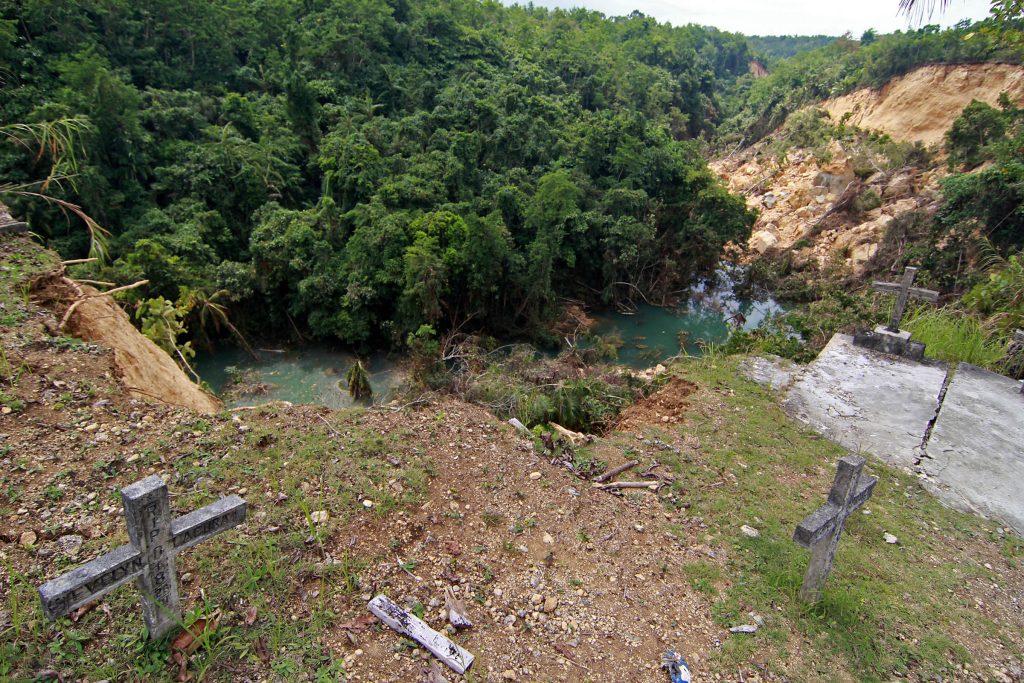
There were no more tears to shed as Saturnino Barace Jr. lighted candles and placed flowers on four tombs in the cemetery on a hill above a rushing river in the town of Antequera, in the central Philippine province of Bohol.
It was All Souls’ Day, the day to remember the dead, weeks after a strong earthquake hit the province in 2013, opening up the ground and claiming the lives of Saturnino’s father, mother, sister, and five-year old niece.
Saturnino still remembers the morning of October 15 that year like it was only yesterday: the chirping of the birds, the gentle breeze that swayed the coconut trees, the occasional barking of the neighbors’ dogs, and the sound of flowing water in a nearby spring.
He and his father, Saturnino Sr, were fixing a wooden bench outside their hut for visitors to sit on when the town celebrates the feast of its patron saint a few days later.
Saturnino’s mother, Emiliana, was doing laundry on the other side of the house. His sister, Elizabeth, a deaf-mute, rested inside the hut, while five-year old niece Shame Jyle was tossing a paper plane in the garden.
Then the leaves rustled, the dogs wailed, the earth moved, and from somewhere beneath their feet came a sound Saturnino never heard before.
“It was like rocks being crushed,” he said. Then the earth shook, five seconds, ten seconds, and longer, “like it would never end,” he said. “It was like we were standing on water.”
“We ran to the middle of the garden, I embraced Shame Jyle, we held each other’s hands, and we dropped on the ground,” remembered Saturnino.
“We were trying to protect Shame Jyle,” he said. But to no avail. The ground opened some ten meters wide and swallowed everything above — trees, rocks, the family’s hut, and the whole family — and buried them some six meters deep.
When he came to, Saturnino realized that he was buried up to his chest. He did his best to free himself, right arm first, then the left.
“I could see my father’s foot in front of me. I heard him struggling for air. I heard my mother, my sister, and my niece moaning,” he recalled.
“The last word I heard from my father was ‘strive.’ As if telling me to do my best to survive, and realize my dreams. Then there was silence.”
He shouted for help but none came. He tried to grab his father’s foot, but the trembling earth prevented him.
“They slipped from my hold,” said Saturnino. “I had difficulty breathing. I thought I would already die. I wanted to die.”
After six hours, neighbors came and dug Saturnino out.
His parents, sister, and niece, however, were gone. Their bodies were retrieved about 36 hours later and brought to the town’s cemetery.

The Baraces were among more than 200 people who perished, and some three million people who were displaced, by the 7.2 Magnitude earthquake that destroyed centuries-old churches, homes, and structures, and even cemeteries, like the one in Antequera where tombs collapsed, exposing bones and skulls, in 2013.
“[The earthquake] may be a reminder from God because of the sins that people commit,” said Saturnino, a farmer who dreamed of working as a driver one day to uplift the lives of his parents.
“But it’s not the end,” he added. “Although I miss them, I am happy that they were together when they left us. They will be happy wherever they are.”
The town’s mayor during that tragic year, Jose Pahang, said the observance of All Souls’ Day “is a reminder… (that) the living must continue living for the dead will take care of themselves.”
“All Souls’ Day is not just a celebration to honor the dead. It is always a celebration of life,” said Father Joel Ruyeras who was then serving as parish priest of nearby Loon town.
“We should all be thankful to God for giving us the opportunity to be here to participate in this wonderful gift that is life,” he said.
Today, the province of Bohol has risen from rubble. Houses and churches have been rebuilt, and the people, strengthened by their Catholic faith, have moved on hoping that someday they will be united with their loved ones in a place where there will be no earthquakes.
“The pain of loss is very real,” said Father Ruyeras. “But the faith of the people in the resurrection is all the more real.”
The priest described it as “a kind of tension between pain and hope.”
“In the midst of these trying times, and even in the midst of death, the only thing that matters, and the real treasure that we have right now, is our faith,” he said.
Source: Licas Philippines
0 Comments